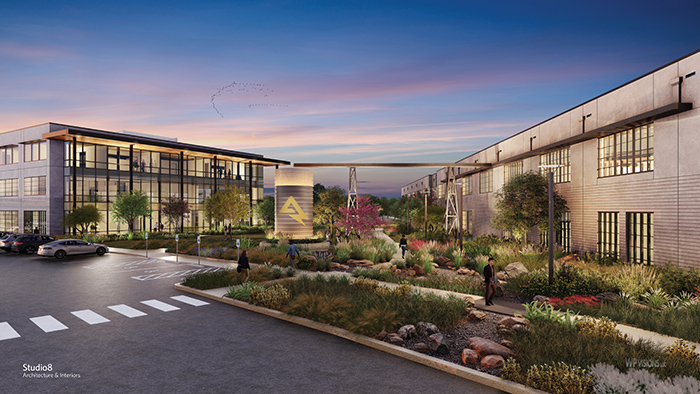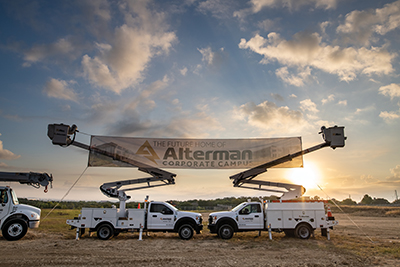
Construction Today celebrates 100 years of Alterman
Just to warn you, I love talking about Alterman. I could go on forever. So, if I start running on and on, please feel free to cut me off and I will make sure I stop!”
As President & CEO of Alterman, it’s part of Greg Padalecki’s job to sing the company’s praises. Immediately, though, it becomes apparent this isn’t just a PR exercise.
Sure, he’s at the top of the pyramid. But that wasn’t always the case.
Indeed, a young Greg joined the firm in 1999 as an apprentice. He slowly worked his way up through the company ranks: driving service trucks, estimating, and managing projects of increasing size before eventually taking the helm as President in 2019 and CEO in 2020.
Nearly two-and-a-half decades on from joining Alterman’s apprenticeship scheme, Greg remains as enthusiastic now about the electrical construction company as he was then – fresh-faced and a newcomer in the construction game.
Right away, he’s taking this opportunity to point out how Alterman’s people-focused structure works to set the company apart from its competitors.
“Though I’m the CEO, I don’t own the company; rather, I own about this much,” he says, displaying a tiny gap – no more than half an inch – between his thumb and forefinger. “Just a tiny bit!”
 As he goes on to explain, Alterman operates with an Employee Stock Ownership Plan (ESOP), meaning that, like everyone else, Greg is part-employee, part-owner. His interests in the firm mirror those on-site, on the shop floor, and in the office alike.
As he goes on to explain, Alterman operates with an Employee Stock Ownership Plan (ESOP), meaning that, like everyone else, Greg is part-employee, part-owner. His interests in the firm mirror those on-site, on the shop floor, and in the office alike.
“It’s our secret sauce,” he asserts. “As a result of the ESOP framework, we proudly take ownership of our company-wide actions and attitudes, which in turn shapes how we present ourselves to customers.
“In fact, I would go as far as to say that sharing stock ownership across our employee network is the main reason behind our incredible growth. Undoubtedly, ESOP has helped bring Alterman to where it is today.” Humble beginnings
To understand just how far the Texas-based business has come, it’s worth going right back to the beginning. “When you think about what the world looked like in 1923,” says Greg, “it’s almost like a different world, especially in terms of its electrical network.”
Lightbulbs were being slowly integrated into new builds, but they were not as commonplace as they are today. Naturally, there wasn’t a huge amount of work in the field.
But that didn’t stop a young Nathan Alterman. As Greg tells it, Nathan began the company as a one-man band when he was just 24 years old, plying his trade by painstakingly pushing a shopping cart up and down Houston Street in downtown San Antonio.
If someone needed their lightbulb changed, then he was there to do it. He just pushed his cart to the job site and started working.
Dependable and reputable
During the pre-war era, remodeling became the mainstay of the business, but the key project of that time was a beautification development for the San Antonio River. By the time of completion, Nathan and his small team had placed conduit and wiring along the banks and under bridges, facilitating the lighting of the Arneson River Theater and various walkways along the route.
“Since our founding, we have grown an awful lot,” says Greg. “In fact, we’re so big now that often people think the company has experienced one long period of steady, even progress; however, in reality, it’s been one long string of challenges!
“In the early 1950s, for instance, when Nathan handed the company over to his son, Richard, there were just three others working for the company. So, it’s not like Alterman has always been hugely successful – it has seen tough times, too.”
Things started to change in the late 1960s when the World’s Fair came to San Antonio. HemisFair ’68, as it was known, attracted over six million visitors and cost an estimated $156 million to put on, with the aim of uniting the different cultures of San Antonio and solidify the city as a cultural and historic hotspot.
But, as Greg details, it also served to put Alterman on the map. “HemisFair ’68 was a significant moment in the company’s history,” he notes. “It acted as the perfect backdrop to display our abilities as a large contractor.”
In total, Alterman completed 30 projects at the fair, bringing recognition to the brand. From then on, it was perceived by Texans as a dependable and reputable electrical contractor, resulting in an explosion of work over the next couple of decades.
Hospitals, manufacturing plants, hotels, regional shopping malls, high-rise office buildings. There was very little that Alterman didn’t work on.
“Today,” Greg circles back, “we have 1300 employees, with roughly 250 in the office and the remaining figure is made up of our field electricians who operate throughout Dallas, San Antonio, Austin, and El Paso.”
Future focus
It’s an impressive story of growth – and this year, that story turns 100. With a century of history behind it, Alterman is set on celebrating in style. “We are in the process of building our new headquarters, a new home for our workforce,” reveals Greg.
Located northeast of San Antonio in a city called Live Oak, the building will come in at an impressive 90,000 square feet. In total, though, the site covers 20 acres, allowing the company to also incorporate an integrated 108,000-square-foot manufacturing facility. 
“The latter means we can enhance our off-site prefabrication processes,” says Greg. “It’s simply a kitting strategy: we create packages for the field that includes the tools, materials, prefabricated assemblies, and all the information needed.
“These will be delivered at the right time to the right job,” he goes on. “So it’s much more efficient in terms of productivity. We’re calling it PACK, short for Packaged Alterman Construction Kit. It’s catchy! We’ve even given out t-shirts and bumper stickers to promote the development. We want to get everyone rallied behind it.”
However, the new centennial development would’ve never made it past the initial planning stage if it wasn’t for a certain criterion. “If we weren’t an ESOP-based business, then we simply would not have been able to accommodate the significant cost of our new headquarters and PACK facility,” says Greg.
“Fortunately, because we are all part-employees and part-owners, we can justify the investment back into our business and ourselves,” he continues. “That philosophy of self-improvement has a knock-on impact when it comes to our culture.
“Every year, we want to get better, continuing on our path of continuous development. Therefore, we look at the money we make from this point of view.
“At the same time, each of our employee-owners see the investment as part of their future. It signals there will be a solid foundation for their future retirements since that prospect is inextricably tied to the success that Alterman has today.”
In that vein, argues Greg, the company is built to live forever. Employee-owners are dubbed Altermanians, and they will each receive a generous retirement package in recognition of their status.
“We want to continue to create and celebrate special moments for Altermanians,” say Greg. “If they retire in three, five, or ten years from now, we want to remain consistent in our appreciation. ESOP makes this possible.”
Talking of years to come, as our conversation with Greg winds to a close, we’re keen to uncover what Alterman has in its pipeline. “There is a ton of mission critical data center work across Texas, and currently we’re focusing on that,” he details.
“On top of that, we’re seeing an increase in demand for waste water treatment upgrades and utilities as well as outdoor substation work across state,” Greg adds. “I’d say we’re hyper-focused on these as we look towards the future.
“To upscale operations and make the most of these opportunities, we’re intent on developing internal processes, which will inevitably be essential to facilitate our expansion plans.”
Despite these growth ambitions, Greg assures us that Alterman will remain the people-focused company it always has been. “We like to think of ourselves as a big, small company,” he concludes.
“Our processes and policies are always tied to the company’s family-feel, which again goes back to the advantages of the ESOP model. Yet, at the same time, we need to create processes and policies that can scale to what we are going to become in the future.
“As it stands, we find ourselves in this stage of metamorphosis, transitioning from a small family to a big family – all without losing the feeling of the former.
“It’s been that way for a century, and we don’t see it fading any time soon. Here’s to another hundred years!”